╔
Palazzo Biscari affacciato sulla terrazza a mare di Catania
Il palazzo dei Principi di Biscari è, con il Monastero San Niccolò l’Arena, il maggiore edificio settecentesco catanese. Sorge su un tratto delle mura cinquecentesche della Città, sulle quali, subito dopo il terremoto del 1693, Ignazio Paternò Castello III Principe di Biscari (m. 1699), ottenne il permesso di elevare il Palazzo dal luogotenente generale Giuseppe Lanza duca di Camastra, artefice della ricostruzione di Catania, inviato del Re di Spagna Carlo II d’Asburgo. Fu sede di un Museo di archeologia, numismatica, scienze naturali, fondato “studiosorum commodo” da Ignazio Paternò Castello V Principe di Biscari nel 1758 e meta di numerosi viaggiatori e uomini di cultura da ogni parte d’Europa. Il palazzo, di stile tardo barocco sulla terrazza a mare, neoclassico, dalle alte colonne, sul lato a levante, nelle sale interne è influenzato dal gusto austriaco che permeava la Corte al tempo di Maria Carolina, figlia di Maria Teresa d’Austria e moglie di Re Ferdinando IV di Borbone.
The Palace of the Princes of Biscari, along with the Monastery of San Nicolò l’Arena, is one of the largest 18th-century buildings in Catania. It stands on a segment of the city’s 16th-century walls, on which, shortly after the 1693 earthquake, Ignazio Paternò Castello, the 3rd Prince of Biscari (d. 1699), obtained permission to elevate the palace from the general lieutenant Giuseppe Lanza, Duke of Camastra. The Duke was the architect of Catania’s reconstruction, sent by King Charles II of Spain from the House of Habsburg. The palace housed a museum of archaeology, numismatics, and natural sciences, founded for the “studiosorum commodo” by Ignazio Paternò Castello, the 5th Prince of Biscari, in 1758. It became a destination for numerous travelers and intellectuals from all over Europe. The palace, featuring late Baroque style on the sea-facing terrace and neoclassical style with tall columns on the east side, reflects the Austrian taste that permeated the court during the time of Maria Carolina, daughter of Maria Theresa of Austria and wife of King Ferdinand IV of Bourbon, in its interior rooms.
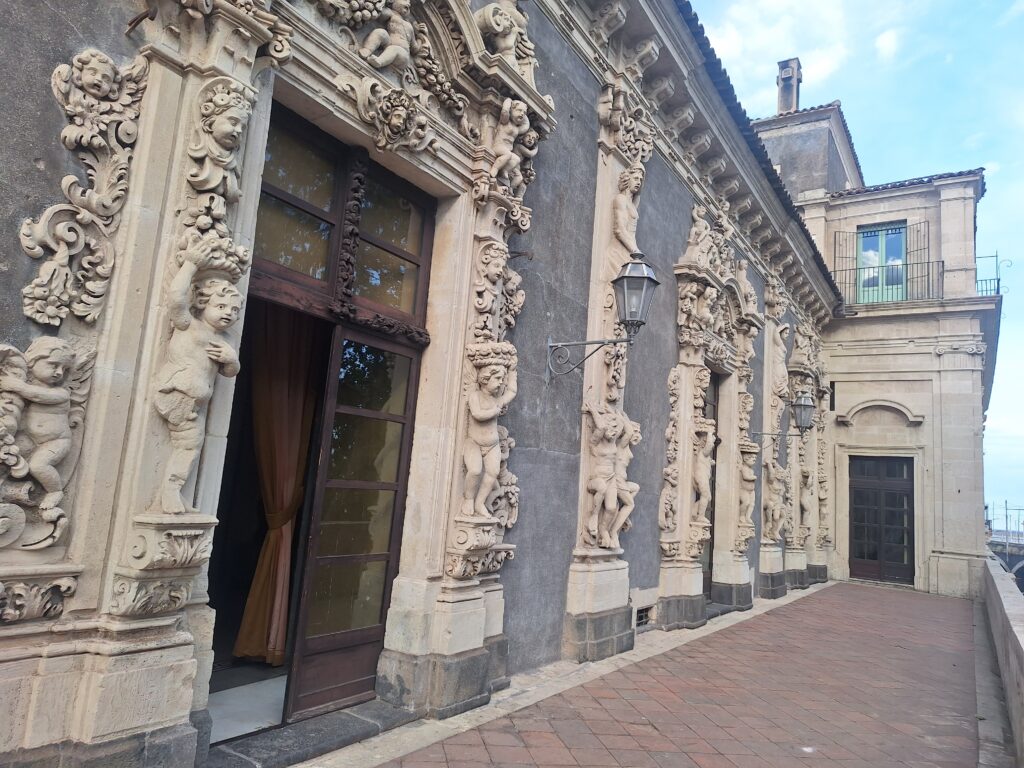
Il prospetto esterno del Palazzo, il suo fronte più ricco guarda verso il mare. (Fotografia: Archivio personale di Lorenzo Moncada).
The exterior facade of the palace, its richest front, faces the sea. (Photo: Personal archive of Lorenzo Moncada).
I saloni ospitano una quadreria e grandi vedute napoletane (Eustachio Pesci 1776); la sala maggiore (detta “Salone dell’Orchestra”) è un vero auditorium, d’impianto ovale, dall’acustica mirabile, dove i musici siedono lungo un largo, alto ballatoio circolare posto tra il soffitto e il pavimento. Palazzo Biscari ha il vanto d’essere stato meta di eminenti personaggi (J.W.Goethe tra questi), uomini di scienza, filosofi, viaggiatori, artisti, esponenti dell’Illuminismo europeo e italiano (Danesi, Inglesi, Tedeschi, Francesi, Polacchi). In queste sale si intrecciarono legami culturali scambi di esperienze, doni archeologici e naturalistici. Il Principe Ignazio fu membro corrispondente della celebre The Society of Antiquaries of London fondata nel 1718 e intrattenne corrispondenza, tra gli altri, con Sir Thomas Hollis, committente del Canaletto; con Francesco Milizia noto illuminista pugliese, che lo cita tra gli architetti italiani; l’abate Domenico Sestini, storico e numismatico del granduca di Toscana, a lungo ospite del principe Ignazio.
Inorgoglisce i discendenti che tutti lodino non solo la cultura, ma soprattutto la cortesia e l’ospitalità dei padroni di casa, i quali, nell’ultimo quarto del XVIII secolo fecero a pieno titolo parte della comunità culturale d’Europa. Il Museo fu donato dalla Famiglia al Comune di Catania nel 1934. Oggi ha sede nel Castello Ursino.
The halls house a picture gallery and large Neapolitan vistas (Eustachio Pesci, 1776). The main hall (known as the “Orchestra Hall”) is a true auditorium with an oval layout and remarkable acoustics. Musicians sit along a large, high circular balcony situated between the ceiling and the floor. Palazzo Biscari prides itself on having been a destination for eminent figures, including J.W. Goethe, scientists, philosophers, travelers, artists, and representatives of the European and Italian Enlightenment (Danes, English, Germans, French, Poles). Cultural connections, exchanges of experiences, and archaeological and naturalistic gifts were established in these rooms. Prince Ignazio was a corresponding member of the renowned Society of Antiquaries of London, founded in 1718, and corresponded with Sir Thomas Hollis, a patron of Canaletto; Francesco Milizia, a noted Enlightenment figure from Apulia, who mentions him among Italian architects; and Abbot Domenico Sestini, historian and numismatist of the Grand Duke of Tuscany, who was a long-time guest of Prince Ignazio.
It fills the descendants with pride that everyone praises not only the culture but also the courtesy and hospitality of the hosts, who, in the last quarter of the 18th century, were full members of the European cultural community. The museum was donated by the family to the Municipality of Catania in 1934. Today it is housed in the Ursino Castle.
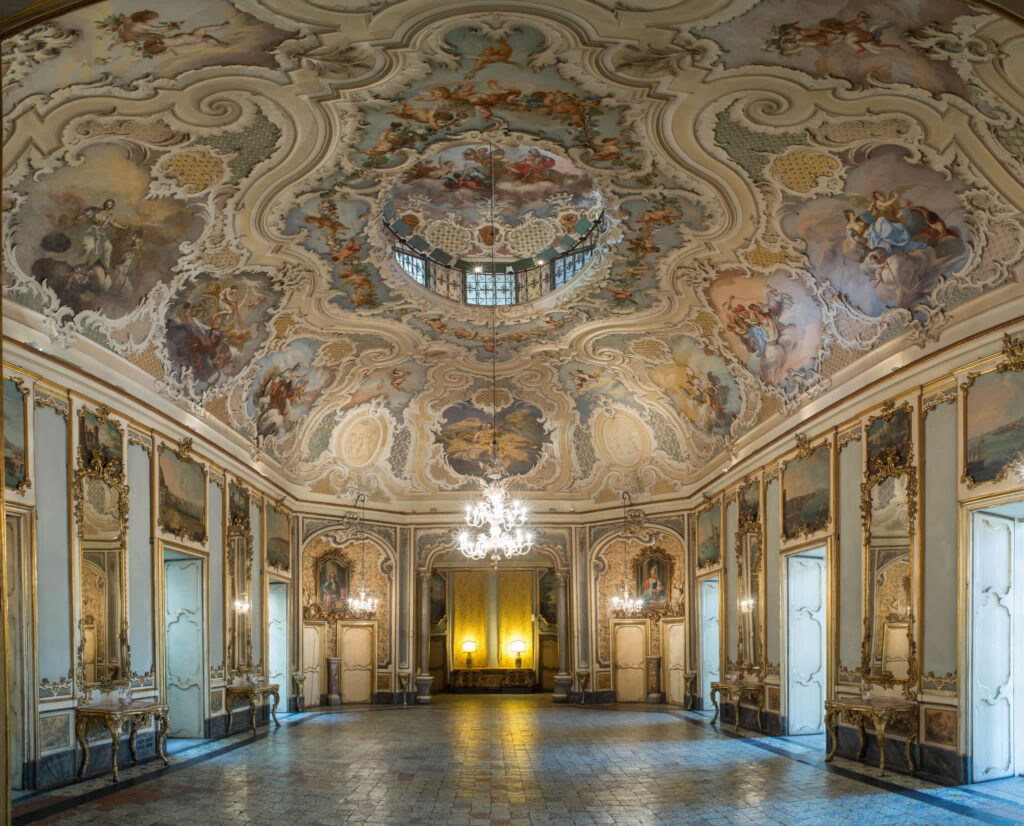
La sala maggiore di Palazzo Biscari, detta “Salone dell’Orchestra”. (Fotografia: Archivio personale di Lorenzo Moncada).
The main hall of Palazzo Biscari, known as the “Orchestra Hall.” (Photo: Personal archive of Lorenzo Moncada).
Abbondanza, Prosperità, Fertilità e Saggezza sono i temi raffigurati nei gruppi allegorici delle decorazioni del prospetto esterno del Palazzo, il suo fronte più ricco che guarda verso il mare. Realizzato (1707) e costruito sulle cinquecentesche mura di Carlo V, esso appare come la porta d’ingresso della città per chi proviene dal mare. La posizione favorevole sul vecchio porto della città ne rende naturale l’evoluzione come centro culturale, sociale e logistico della famiglia; nei magazzini che affacciavano sul molo era facile stoccare i beni che, prodotti lontano, venivano via mare trasportati in città.
Di grande impatto è la visione dei balconi e delle lesene in pietra bianca di Siracusa che emergono dal fondo nero della base lavica con decorazioni a fiori, putti, fauni e telamoni. Costituita da sette grandi vetrate che racchiudono sculture e decorazioni di buona fattura in stile barocco siciliano. Il prospetto su Via Museo Biscari non ha alcun rilievo ad eccezione del portale, notevole per dimensioni e ricchezza, “assettato” i primi del 700 e recante le armi di Vincenzo IV principe. Da qui si accede al vasto cortile, un tempo ricco di alberi, aiuole, pergolati, oggi spoglio; di fronte il portone è l’’importante scalinata a tenaglia che ascende alla grande sala dove sono le tele che illustrano i feudi di casa Biscari. Da lì si passa nella Sala Verde, ricca di quadri e sovraporte, con un bel pavimento di cotto con intarsi di pietra bianca di Siracusa.
La successiva Sala Rossa ospita grandi ritratti degli eminenti personaggi di Casa Biscari e altre tele di grandi dimensioni. Paesaggi, repliche di tele famose (una da Luca Giordano) quadri d’argomento storico……
Da questa ci si immette nel grande Salone, detto “dell’Orchestra”, singolare esempio di rococò napoletano. Lo ornano grandi sovraporte con vedute della capitale del Regno, Napoli, del suo Golfo, del Vesuvio e dei dintorni. L’affresco sul soffitto, il Consiglio degli Dei, celebra la gloria di casa Biscari.
Soluzione architettonica di rilievo, la volta ospita al suo culmine un largo ballatoio che riprende il contorno ovale del Salone e che ospitava i musici. Il ballatoio infatti è limitato da una ringhiera che reggeva le candele e gli spartiti musicali. Nel settecento la musica era nel coltivata dalle grandi Famiglie che avevano alle loro dipendenze Maestri spesso di vaglia.
Qui prendevano posto i musici, appena visibili da chi stava in basso. Ad essa si accede tramite una scala decorata a stucco (che il principe Ignazio chiamò “a fiocco di nuvola”) all’interno della grande galleria affacciata sulla marina.
Alle specchiere, le bianche porte e il rilucente pavimento si accompagnano grandi specchi posti su due camini, ognuno in una nicchia, i quali, quando sono accesi, con loro luce, riflessa, nel mondo allusivo del rococò, evocano il fuoco, il cui dio, Vulcano, occhieggia dall’affresco del soffitto.
I materiali e le forniture furono spesso preferite tra quelle che potevano più facilmente viaggiare via mare per giungere favorevolmente ed essere sbarcate direttamente ai piedi del costruendo edificio.
Abundance, Prosperity, Fertility, and Wisdom are the themes depicted in the allegorical groups of decorations on the exterior facade of the palace, its richest front facing the sea. Built in 1707 and constructed on the 16th-century walls of Charles V, it appears as the gateway to the city for those arriving from the sea. Its favorable position on the old city port naturally led to its evolution as a cultural, social, and logistical center for the family; the warehouses facing the pier made it easy to store goods that, produced far away, were transported to the city by sea.
The vision of the balconies and pilasters in white Syracuse stone emerging from the black lava base with decorations of flowers, putti, fauns, and telamons is striking. The facade is composed of seven large windows enclosing sculptures and well-crafted decorations in the Sicilian Baroque style. The facade on Via Museo Biscari has no relief except for the portal, remarkable for its size and richness, “assembled” at the beginning of the 1700s and bearing the arms of Vincenzo IV, the prince. From here, one enters the vast courtyard, once rich with trees, flower beds, and pergolas, now bare; opposite the gate is the important double staircase that ascends to the large hall where the canvases illustrating the Biscari estates are displayed. From there, one moves into the Green Room, rich with paintings and overdoors, with a beautiful terracotta floor with white Syracuse stone inlays.
The next Red Room houses large portraits of prominent members of the Biscari House and other large canvases. Landscapes, replicas of famous paintings (including one by Luca Giordano), and historical subject paintings…
From here, one enters the large hall known as the “Orchestra Hall,” a singular example of Neapolitan Rococo. Large overdoors with views of the capital of the Kingdom, Naples, its Gulf, Vesuvius, and the surroundings adorn it. The fresco on the ceiling, the Council of the Gods, celebrates the glory of the Biscari house.
A significant architectural solution, the vault houses at its apex a large balcony that follows the oval contour of the hall and once hosted musicians. The balcony is bordered by a railing that held candles and music scores. In the 18th century, music was cultivated by great families who often had notable masters in their employ.
Musicians took their places here, barely visible to those below. It is accessed via a staircase decorated with stucco (which Prince Ignazio called “cloud ribbon”) within the large gallery overlooking the marina.
Mirrors, white doors, and the gleaming floor accompany large mirrors placed on two fireplaces, each in a niche, which, when lit, with their reflected light, evoke the fire, whose god, Vulcan, peers from the ceiling fresco in the allusive world of Rococo.
Materials and supplies were often chosen from those that could most easily travel by sea to be favorably landed directly at the foot of the building under construction.
Gli appartamenti privati
The Private Apartments
Adiacente ai saloni vi è una piccola suite, gli appartanti privati dei padroni di casa, che accoglie una stanza foderata da una boiserie in legno di rosa ed un pavimento “a commesso” ottenuto assemblando secondo il gusto settecentesco, frammenti di marmo romani. Boiseries, intarsi, specchi, affreschi, porcellane, cineserie si ritrovano nelle stanze dell’appartamento del primo piano, che ospita la Galleria degli Uccelli e la Stanza di Don Chisciotte. Nella Galleria, ricca di specchi e già costellata da piccole diafane porcellane, si stende un pavimento di mattonelle ceramicate (che i documenti d’archivio dicono “vìsole”). I pannelli e le porte presentano una mostra delle più diverse specie di uccelli, accompagnati da svolazzanti cartigli che ne recano il nome scientifico. Nella boiserie della Stanza di Don Chisciotte sono inserite tele (di Autore ignoto) che illustrano le imprese dell’hidalgo, tratte dai disegni di Charles Coypel, pittore francese cui dobbiamo i cartoni preparatori per gli arazzi di questo soggetto commissionati da Carlo III di Borbone (re delle Due Sicilia dal 1734 al 1759) per la Reggia di Caserta.
Adjacent to the halls is a small suite, the private apartments of the hosts, which includes a room lined with rosewood boiserie and a “commesso” floor obtained by assembling Roman marble fragments according to 18th-century taste. Boiseries, inlays, mirrors, frescoes, porcelains, and chinoiseries are found in the rooms of the first-floor apartment, which houses the Galleria degli Uccelli and the Stanza di Don Chisciotte. The gallery, rich with mirrors and once dotted with small, diaphanous porcelains, features a floor of ceramic tiles (which archival documents call “vìsole”). The panels and doors present a display of various bird species, accompanied by fluttering cartouches bearing their scientific names. In the boiserie of the Stanza di Don Chisciotte, paintings (by an unknown artist) illustrating the exploits of the hidalgo, based on drawings by Charles Coypel, a French painter who created preparatory cartoons for tapestries of this subject commissioned by Charles III of Bourbon (King of the Two Sicilies from 1734 to 1759) for the Royal Palace of Caserta, are inserted.
Architetti e artisti
Architetti e artisti
Gli architetti chiamati alla costruzione del Palazzo furono Alonzo Di Benedetto, per la parte più antica; Girolamo Palazzotto e Francesco e Antonino Battaglia per l’ampliamento verso est e gli spazi museali. Tra gli artisti coinvolti lo scultore messinese Antonino Amato per la decorazione dei sette splendidi finestroni affacciati sulla marina e Giovanbattista Piparo per alcuni affreschi. Specchi, stucchi e altri affreschi sono di Matteo Desiderato; di Sebastiano Lo Monaco l’affresco sul soffitto.
Le sovraporte nel salone dell’orchestra sono opera di Eustachio Pesci, che dedicò ad Ignazio Biscari una sua incisione.
The architects called to build the palace were Alonzo Di Benedetto, for the oldest part; Girolamo Palazzotto and Francesco and Antonino Battaglia for the eastward expansion and museum spaces. Among the artists involved were the Messina sculptor Antonino Amato for the decoration of the seven splendid windows overlooking the marina and Giovanbattista Piparo for some frescoes. Mirrors, stuccoes, and other frescoes are by Matteo Desiderato; the ceiling fresco is by Sebastiano Lo Monaco.
The overdoors in the orchestra hall are the work of Eustachio Pesci, who dedicated an engraving to Ignazio Biscari.
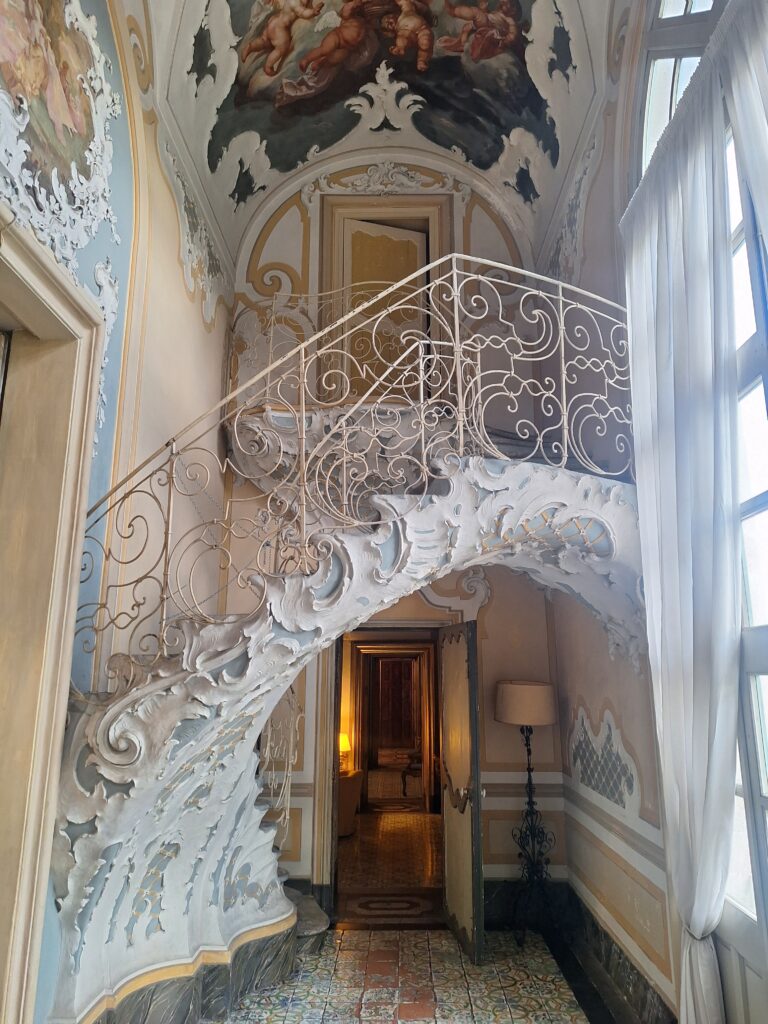
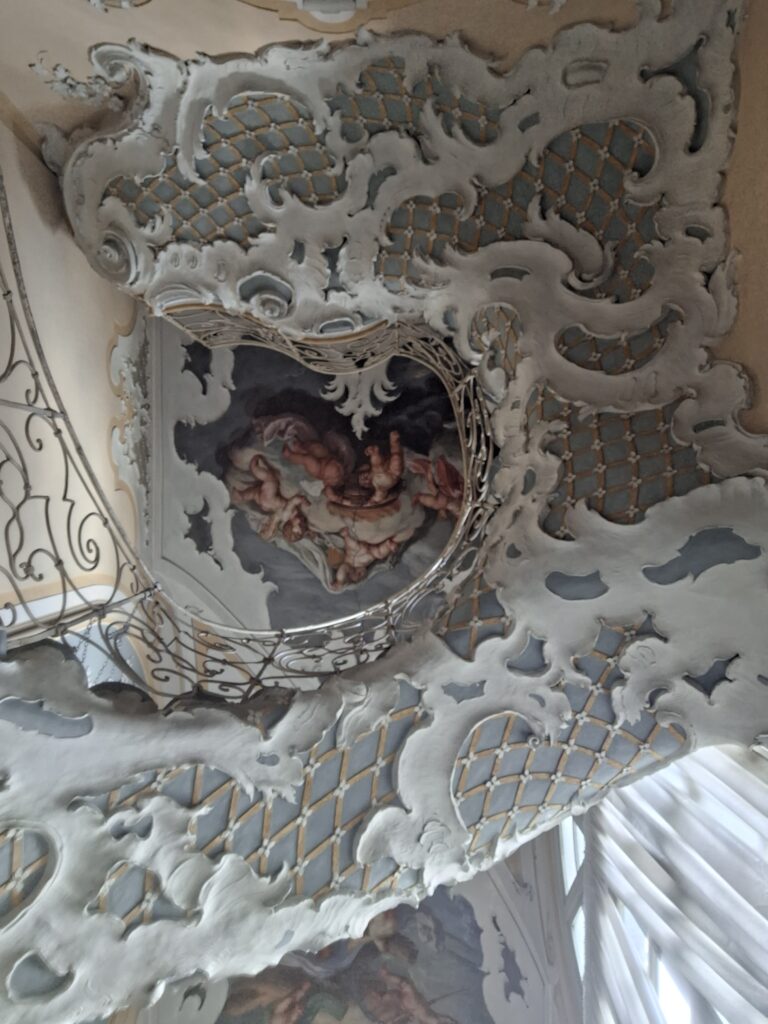
La scala decorata a stucco “a fiocco di nuvola” all’interno della galleria affacciata sulla marina. (Fotografia: Archivio personale di Lorenzo Moncada).
The staircase decorated with stucco “cloud ribbon” within the gallery overlooking the marina. (Photo: Personal archive of Lorenzo Moncada).
Le collezioni dei Principi Biscari
The Collections of the Princes of Biscari
Le ampie sale ornate di colonne, disposte intorno a due cortili racchiudevano pregevoli collezioni di monete, medaglie, gemme intagliate, cammei antichi ed ambre lavorate, disegni, stampe e armature, ricordate ed elogiate nei diari dei numerosi eruditi di tutta Europa che nel Settecento vennero a visitarlo. Goethe è forse il più famoso, ma già cinquant’anni prima di lui eminenti visitatori da tutta Europa (Danimarca, Russia, Germania, Polonia, Spagna, Francia, Inghilterra) e da tutti gli Stati italiani (Regno di Sardegna, Granducato di Toscana, Stato della Chiesa). Gran parte delle collezioni raccolte nel Museo del Principe di Biscari furono donate nel 1934 al Comune di Catania e trasferite al Museo Civico di Castello Ursino, dove sono parzialmente esposte.
The large halls, adorned with columns and arranged around two courtyards, housed fine collections of coins, medals, engraved gems, ancient cameos, and worked ambers, drawings, prints, and armor, remembered and praised in the diaries of the numerous scholars from all over Europe who came to visit in the 18th century. Goethe is perhaps the most famous, but fifty years before him, eminent visitors from all over Europe (Denmark, Russia, Germany, Poland, Spain, France, England) and from all Italian states (Kingdom of Sardinia, Grand Duchy of Tuscany, Papal States) had already come. Most of the collections gathered in the Prince of Biscari Museum were donated in 1934 to the Municipality of Catania and transferred to the Civic Museum of Ursino Castle, where they are partially exhibited.
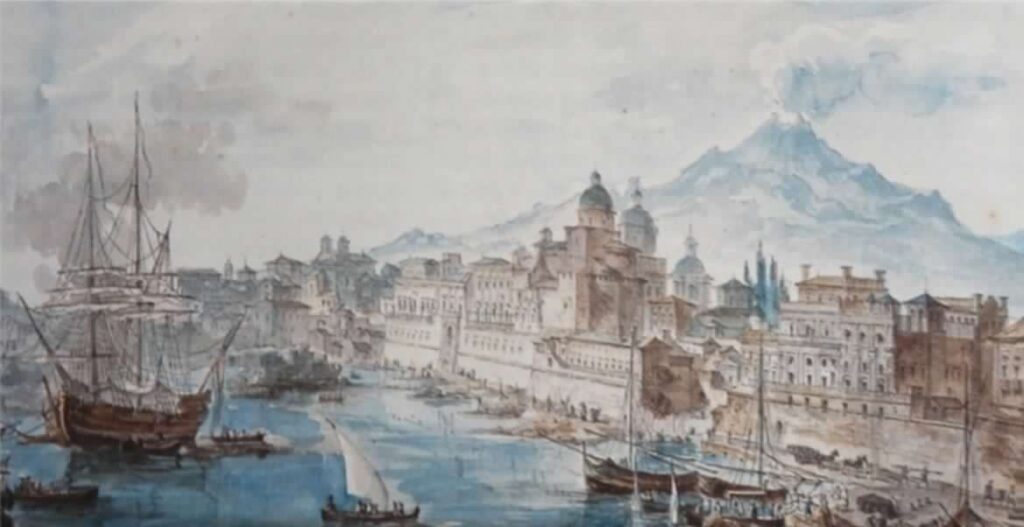
Vista della città e del porto di Catania, sullo sfondo l’Etna. Dipinto di Louis Jean Desprez. (Fotografia: Archivio personale di Lorenzo Moncada).
View of the city and port of Catania, with Mount Etna in the background, painting by Louis Jean Desprez. (Photo: Personal archive of Lorenzo Moncada).
Oggi
Today
Il Palazzo è ancora oggi abitato dai discendenti della Famiglia e i suoi saloni sono usati per eventi e manifestazioni culturali, mostre, conferenze, convegni, concerti.
The palace is still inhabited by the descendants of the family, and its halls are used for events and cultural activities, exhibitions, conferences, conventions, and concerts.
IMMAGINE INIZIALE | Palazzo Biscari con vista sugli archi della marina. (Foto: Archivio personale di Lorenzo Moncada).
HEAD IMAGE | Palazzo Biscari with a view of the marina arches. (Photo: Personal archive of Lorenzo Moncada).